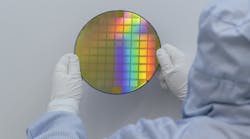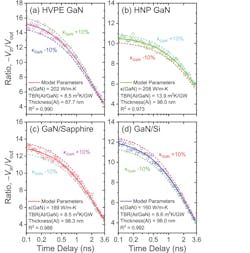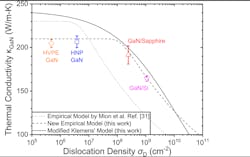Semiconductors based on gallium-nitride (GaN) substrates are increasingly important in the power-device landscape. Their thermal conductivity, and thus their ability to conduct and so dissipate heat, is also a critical parameter.
A two-person team, based at the Nick Holonyak, Jr. Micro and Nanotechnology Laboratory at the University of Illinois at Urbana-Champaign, measured the thermal conductivity of four commonly used GaN substrate implementations along with other defining attributes. They noted that GaN thermal conductivity is reported to range from 110 to 269 W/m-K, which suggests a strong dependence not only on growth methods and conditions, but also measurement techniques and assumptions.
They noted that the standard thermal models as well as their relationship to dislocation densities may not be adequate given the different approaches (note that these dislocations adversely affect GaN-device performance). They anticipate that their new, presumably more-accurate model of the relationship between fabrication approach and the associated dislocation densities will lead to improved GaN process, thermal, and other models.
To do this, the researchers fabricated and tested four standard techniques used for fabricating c-plane GaN substrates, and measured their resultant thermal conductivity (κGaN) factors as follows:
- 350-μm-thick freestanding GaN grown by hydride vapor phase epitaxy (HVPE): 204.7(±4.6) W/m-K
- 350-μm-thick freestanding GaN grown by high nitride pressure (HNP): 206.6 (±6.8) W/m-K
- 4.5-μm-thick GaN grown on the sapphire substrate by metal-organic chemical vapor phase deposition (MOCVD): 191.5 (±10.5) W/m-K;
- 5-μm-thick GaN grown on the Si(111) substrate by MOCVD with step-graded AlxGa1-xN, and AlN buffer layers in between: 164.4 (±3.2) W/m-K
To evaluate the thermal conductivity, they employed standard time-domain thermoreflectance (TDTR) techniques with a laser light source generating pulses at an 80-MHz repetition rate. These pulses were split into a pump beam and a probe beam, with the pump beam modulated by an electro-optical modulator using a 200-Hz chopper. A fast-response photodiode detector coupled with an RF lock-in amplifier was then used to pick up the reflected laser signal. The resulting graphs also show the time delay (in seconds) used to allow the thermal energy to propagate through the sample (Fig. 1).


